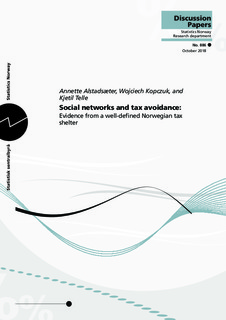| dc.contributor.author | Alstadsæter, Annette | |
| dc.contributor.author | Kopczuk, Wojciech | |
| dc.contributor.author | Telle, Kjetil | |
| dc.date.accessioned | 2018-11-06T10:17:50Z | |
| dc.date.available | 2018-11-06T10:17:50Z | |
| dc.date.issued | 2018-11-02 | |
| dc.identifier.issn | 1892-753X | |
| dc.identifier.uri | http://hdl.handle.net/11250/2571225 | |
| dc.description.abstract | In 2005, over 8% of Norwegian shareholders transferred their shares to new (legal) tax shelters intended to defer taxation of capital gains and dividends that would otherwise be taxable in the aftermath of 2006 reform.
Using detailed administrative data we identify family networks and describe how take up of tax avoidance progresses within a network. A feature of the reform was that the ability to set up a tax shelter changed discontinuously with individual shareholding of a firm and we use this fact to estimate the causal effect of availability of tax avoidance for a taxpayer on tax avoidance by others in the network. We find that take up in a social network increases the likelihood that others will take up. This suggests that taxpayers affect each other's decisions about tax avoidance, highlighting the importance of accounting for social interactions in understanding enforcement and tax avoidance behavior, and providing a concrete example of “optimization frictions” in the context of behavioral responses to taxation. | nb_NO |
| dc.language.iso | eng | nb_NO |
| dc.publisher | Statistisk sentralbyrå | nb_NO |
| dc.relation.ispartofseries | Discussion Papers;No. 886 | |
| dc.subject | Skattereform | nb_NO |
| dc.title | Social networks and tax avoidance: Evidence from a well-defined Norwegian tax shelter | nb_NO |
| dc.type | Working paper | nb_NO |
| dc.subject.nsi | VDP::Samfunnsvitenskap: 200::Økonomi: 210 | nb_NO |
| dc.source.pagenumber | 54 s. | nb_NO |
